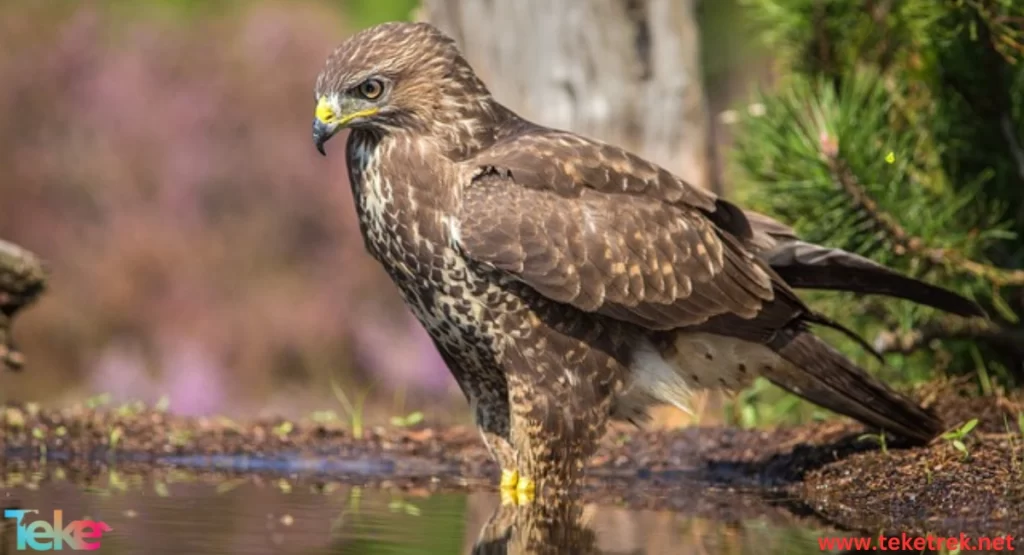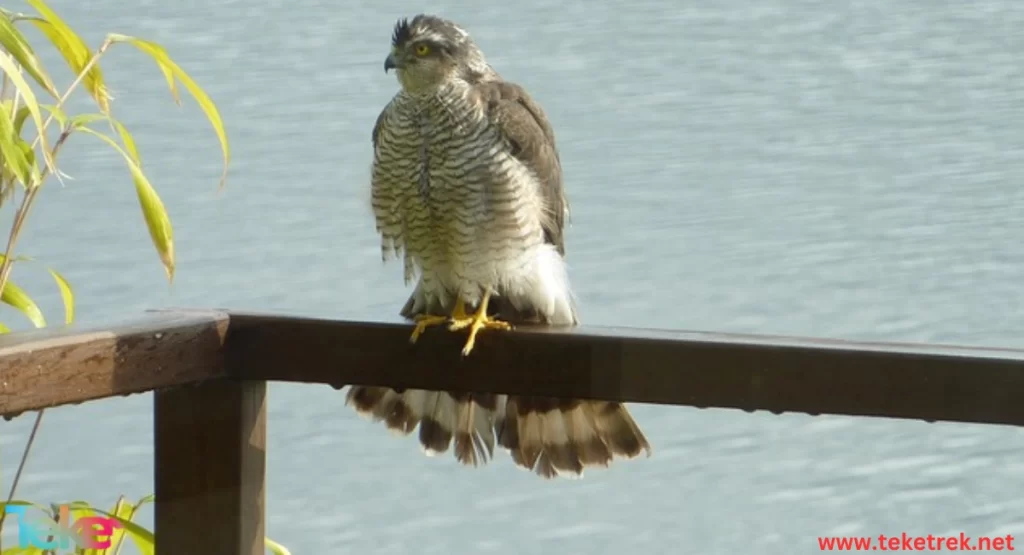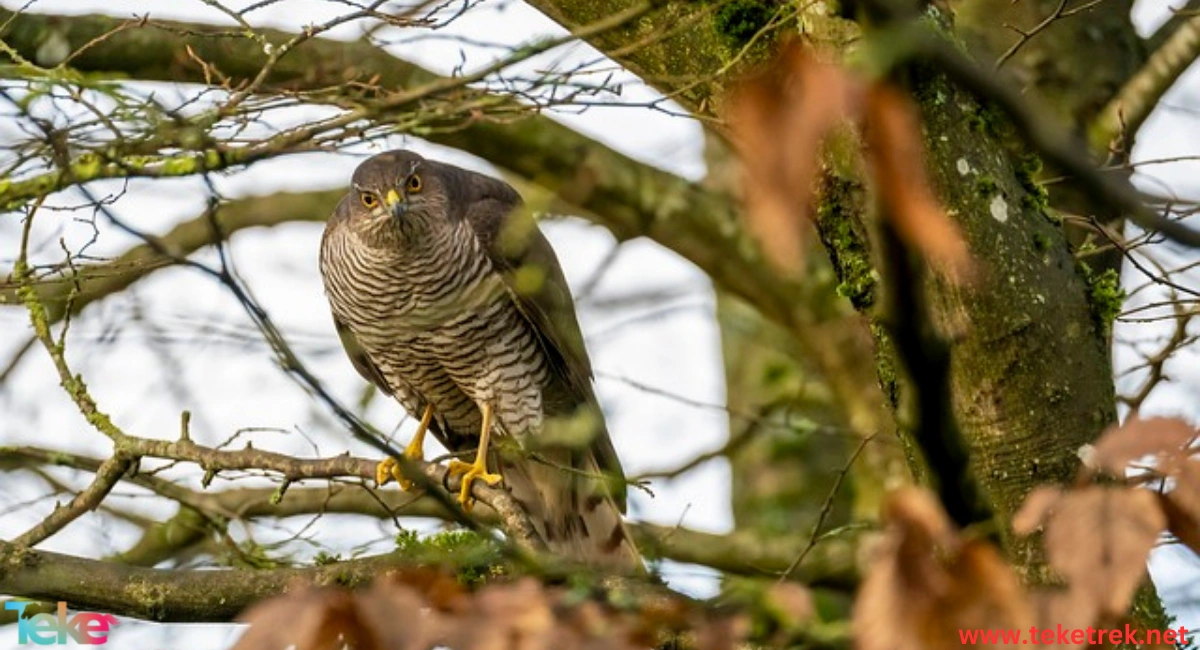The Eurasian Sparrowhawk is a species of bird of prey, closely resembling a falcon to a great extent. It is characterized by its bright yellow eyes, which contribute to its keen eyesight.
The Eurasian Sparrowhawk navigates through dense vegetation with remarkable precision while chasing small birds for prey.
In this article on TekeTrek, you will get to know the Eurasian Sparrowhawk and discover its unique characteristics.

What is the Eurasian Sparrowhawk?
- Scientific Name: The Eurasian Sparrowhawk belongs to the order Accipitriformes, of the family Accipitridae, which includes diurnal birds of prey with strong hooked beaks.
- The Eurasian Sparrowhawk is a small bird of prey native to Europe, Asia, and Africa.
- It inhabits coniferous forests and city gardens in over 100 countries, where it roams around trees and attacks its prey.
- The main food source for the Eurasian Sparrowhawk is small forest birds.
- Female Eurasian Sparrowhawks are usually larger in size than males. Adult male Eurasian Sparrowhawks have grey upperparts and red-barred underparts.
- The Eurasian Sparrowhawk has orange-yellow eyes. Adult female Eurasian Sparrowhawks have dark brown or grey-brown upperparts and brown-barred underparts.
- Eurasian Sparrowhawks are known for their speed and agility. They also produce high-pitched calls such as chattering and sharp alarm calls.
Identifying Characteristics of the Eurasian Sparrowhawk
- The Eurasian Sparrowhawk is a striking bird of prey, known for its agile flight and distinctive physical features.
- To identify this bird of prey, attention should be paid to several key characteristics that distinguish it from other birds of prey.
- Eurasian Sparrowhawks are medium-sized birds of prey, ranging in length from 30 to 40 centimeters.
- They are characterized by their short, rounded wings, which enable them to fly with agility and maneuverability.
- Eurasian Sparrowhawks exhibit a wonderful mix of colors. The upperparts are usually dark gray to black, while the underparts are finely barred in reddish-brown or orange.
- They have bright yellow eyes, sharply contrasting with their dark facial markings. Eye color is an important distinguishing factor when compared to other birds of prey.
Habitat of the Eurasian Sparrowhawk
- Eurasian Sparrowhawks are commonly found in forests and green areas. These birds prefer dense vegetation for nesting and hunting.
- Eurasian Sparrowhawks are found in parts of Australia, New Guinea, and nearby islands. Additionally, they inhabit Europe, Asia, and Africa in over 100 countries, including the United Kingdom, Russia, India, Iran, and Sudan.
- Groups of Eurasian Sparrowhawks living in southern regions do not leave their habitat, as they remain temperate throughout the year. However, those living in northern regions, such as Russia, migrate to warmer climates during the winter.
- These birds prefer moderately dense coniferous forests, requiring appropriately spaced trees.
- Eurasian Sparrowhawks often fly at low altitudes and quickly through vegetation, using their short wings and long tail. They make rapid and precise movements.
Diet of the Eurasian Sparrowhawk
- Eurasian Sparrowhawks are carnivorous animals that hunt their prey through sudden attacks.
- They primarily feed on small forest birds, such as finches, thrushes, warblers, and tits. Additionally, they prey on rodents, bats, field mice, flies, squirrels, as well as rabbits and insects.
Predators of the Eurasian Sparrowhawk
- Natural predators of Eurasian Sparrowhawks include owls, northern goshawks, peregrine falcons, golden eagles, red foxes, and martens.
- Birds of prey may attempt to raid the sparrowhawk’s nest, but females stand guard and successfully evade most intruders.
- Males typically stand watch and make alarm calls.


Breeding and Life Cycle of the Eurasian Sparrowhawk
- Eurasian Sparrowhawks form monogamous pairs during each breeding season, but they may change partners annually.
- In spring, Eurasian Sparrowhawks display to each other to find a mate. Males perform a “roller coaster” flight to impress females.
- Eurasian Sparrowhawks rely on forests to build their nests, constructing them in a low location within the canopy.
- Male Eurasian Sparrowhawks feed their partners extra food before egg laying.
- Studies indicate that heavier females are more successful in laying more eggs. Females lay four or five pale blue eggs with brown markings and incubate them for 33 days.
- More than 20% of chicks older than two days die due to hunger, abandonment, adverse weather, and nest predation.
- Chicks fledge after 24 to 28 days of hatching, but their parents continue to feed them for 30 days.
- These birds reach sexual maturity between one and three years old and have an average lifespan of five years. However, Sparrowhawks can live 20 years or more.
Behavioral Traits of the Eurasian Sparrowhawk
- The Eurasian Sparrowhawk is a skilled hunter, primarily preying on small birds.
- It is known for its stealthy approach when dealing with prey, often relying on speed and surprise to catch its prey.
- These birds are observed maneuvering rapidly through dense vegetation in search of their avian targets.
- While the diet of the Eurasian Sparrowhawk mainly consists of birds, it may occasionally consume insects and small mammals.
Frequently Asked Questions about the Eurasian Sparrowhawk
- Is the Sparrowhawk a falcon?
Yes, the Sparrowhawk is considered a type of falcon. It is small in size, belongs to the Accipitridae family, and is known for its speed and ability to fly for long periods. It is locally called a “falcon” because of its resemblance in shape and physical characteristics to falcons.
How long does a Sparrowhawk live?
The Eurasian Sparrowhawk, scientifically known as Accipiter nisus, lives in the wild between 10 to 20 years.
- What is the call of a Sparrowhawk?
The call of a Sparrowhawk is called “chirring.”
- What does the Sparrowhawk eat?
The Sparrowhawk eats small birds, but it may also occasionally consume bats.
- Why is it called a Sparrowhawk?
The name of the species comes from the Middle English word “sperhauk” and the Old English word “spearhafoc,” which means the falcon that hunts sparrows.
- What does the Sparrowhawk symbolize?
The Sparrowhawk symbolizes inner warrior spirit.
- Is sparrowhawk the name of a lion?
No, the sparrowhawk is not the name of the lion, but rather it is known as the black goshawk.
In conclusion, Eurasian Sparrowhawks have maintained their natural populations and are not at risk of extinction. Some hunters breed this species of birds and keep them as a hobby, for bird hunting, or to protect other birds from them.






